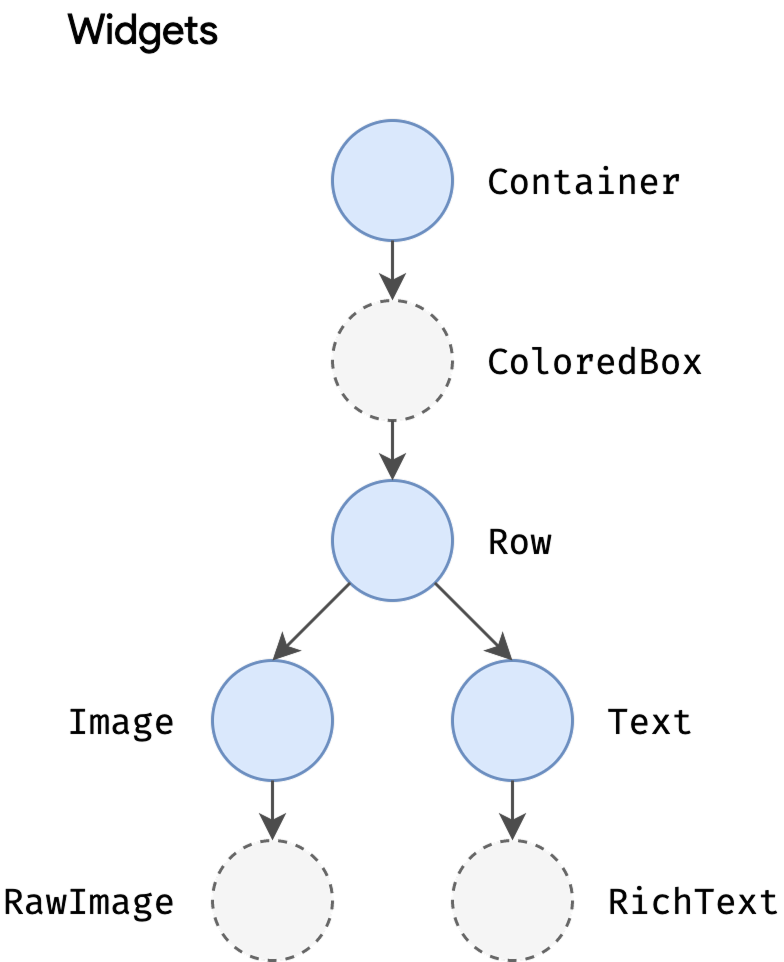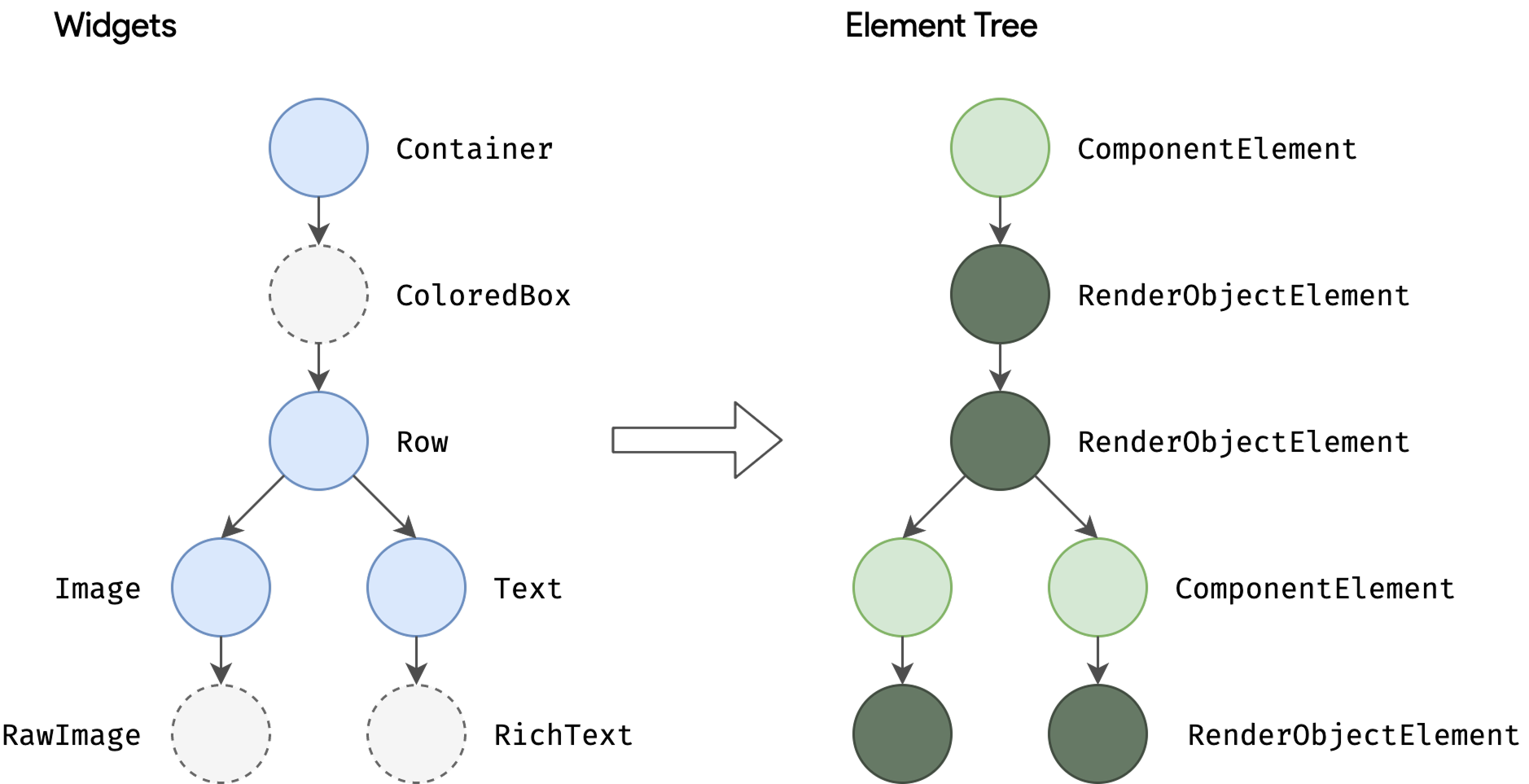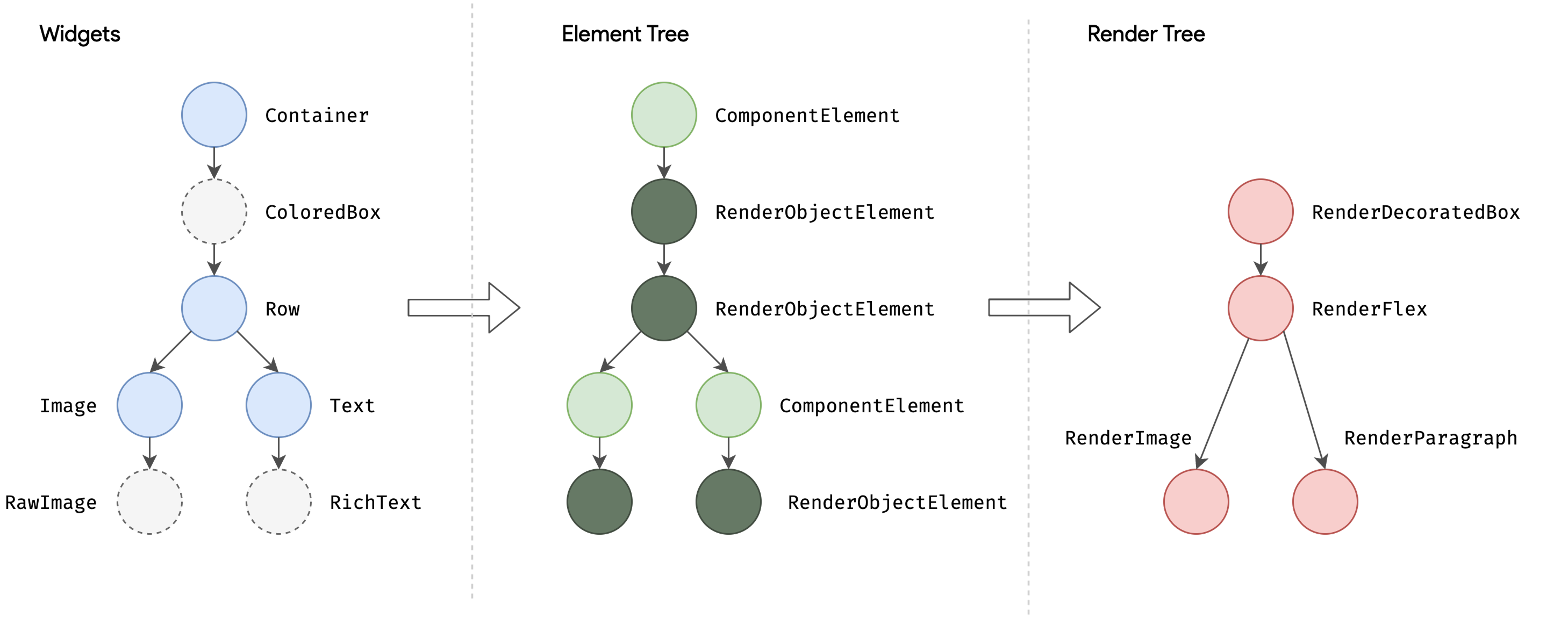深色模式
Flutter 的三棵树
三棵树的简单概念
以下内容取自Flutter官方文档。
假设有一段Widget组件成的简单代码:
dart
Container(
color: Colors.blue,
child: Row(
children: [
Image.network('https://www.example.com/1.png'),
const Text('A'),
],
),
);那么它在运行时,会生成一棵Widget树。

注意,Widget树与代码里的Widget嵌套结构是有区别的,比如上图中,Widget中的Container下面多了一个ColoredBox。
Widget树会生成Element树,元素是1:1对应的关系

注意,Container生成的Element是StatelessElement,它是ComponentElement的子类,图中只取ComponentElement与RenderObjectElement是为了展示它们与Render树的关系
Element树会生成Render树

Render树刚好与Element树中RenderObjectElement结点对应。
顶级元素
三棵树的顶层元素是:
- 顶层
Widget:RootWidget - 顶层
Element:RootElement - 顶层
RenderObject:RenderView
顶级元素的创建--从runApp开始
创建RootWidget
从 runApp() 开始,先把我们写的app类(一般会在build()方法里return一个MaterialApp)包装在View类里面,
然后调用 WidgetsBinding 的 scheduleAttachRootWidget()方法。
dart
void runApp(Widget app) {
final WidgetsBinding binding = WidgetsFlutterBinding.ensureInitialized();
_runWidget(binding.wrapWithDefaultView(app), binding, 'runApp');
}dart
void _runWidget(Widget app, WidgetsBinding binding, String debugEntryPoint) {
assert(binding.debugCheckZone(debugEntryPoint));
binding
..scheduleAttachRootWidget(app)
..scheduleWarmUpFrame();
}接下来,在 WidgetsBinding 中,创建 RootWidget ,并绑定 BuildOwner 实例。
实际上,BuildOwner 是绑定到 RootElement 上的。
dart
@protected
void scheduleAttachRootWidget(Widget rootWidget) {
Timer.run(() {
attachRootWidget(rootWidget);
});
}dart
void attachRootWidget(Widget rootWidget) {
attachToBuildOwner(RootWidget(debugShortDescription: '[root]', child: rootWidget));
}dart
void attachToBuildOwner(RootWidget widget) {
final bool isBootstrapFrame = rootElement == null;
_readyToProduceFrames = true;
_rootElement = widget.attach(buildOwner!, rootElement as RootElement?);
if (isBootstrapFrame) {
SchedulerBinding.instance.ensureVisualUpdate();
}
}创建RootElement
调用链来到 RootWidget 类中,
在 attach() 方法中创建 RootElement 实例,即,调用 RootWidget 的 createElement()方法。
然后,绑定 BuildOwner。
dart
RootElement attach(BuildOwner owner, [RootElement? element]) {
if (element == null) {
owner.lockState(() {
element = createElement();
assert(element != null);
element!.assignOwner(owner);
});
owner.buildScope(element!, () {
element!.mount(/* parent */ null, /* slot */ null);
});
} else {
element._newWidget = this;
element.markNeedsBuild();
}
return element!;
}维护Element树
最后,调用链来到 RootElement 类,调用了 mount() 方法,从顶层开始,递归创建整个 element tree。
注意,在 _rebuild() 方法中,调用了 updateChild() 方法,传递的参数中,传递了 RootWidget 的 child,递归的流程由此开始。
updateChild() 是一个模板方法,它是 element tree 维护更新的核心。
updateChild()的注释写着:Update the given child with the given new configuration.
dart
@override
void mount(Element? parent, Object? newSlot) {
assert(parent == null); // We are the root!
super.mount(parent, newSlot);
_rebuild();
assert(_child != null);
super.performRebuild(); // clears the "dirty" flag
}dart
void _rebuild() {
try {
_child = updateChild(_child, (widget as RootWidget).child, /* slot */ null);
} catch (exception, stack) {
final FlutterErrorDetails details = FlutterErrorDetails(
exception: exception,
stack: stack,
library: 'widgets library',
context: ErrorDescription('attaching to the render tree'),
);
FlutterError.reportError(details);
// No error widget possible here since it wouldn't have a view to render into.
_child = null;
}
}创建RenderView
RenderView的创建时机,在runApp中,当WidgetsBinding准备好以后,就触发了,然后才是调用_runWidget()方法,去创建RootWidget、RootElement。
dart
void runApp(Widget app) {
final WidgetsBinding binding = WidgetsFlutterBinding.ensureInitialized();
_runWidget(binding.wrapWithDefaultView(app), binding, 'runApp');
}dart
Widget wrapWithDefaultView(Widget rootWidget) {
return View(
view: platformDispatcher.implicitView!,
deprecatedDoNotUseWillBeRemovedWithoutNoticePipelineOwner: pipelineOwner,
deprecatedDoNotUseWillBeRemovedWithoutNoticeRenderView: renderView,
child: rootWidget,
);
}dart
late final RenderView renderView = _ReusableRenderView(view: platformDispatcher.implicitView!);dart
class _ReusableRenderView extends RenderView {
// ...
}所以,其实RenderView先于RootWidget和RootElement被创建,不过这不重要,因为我们优先关注RootWidget和RootElement。
